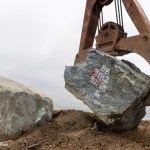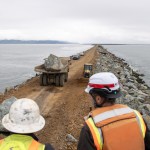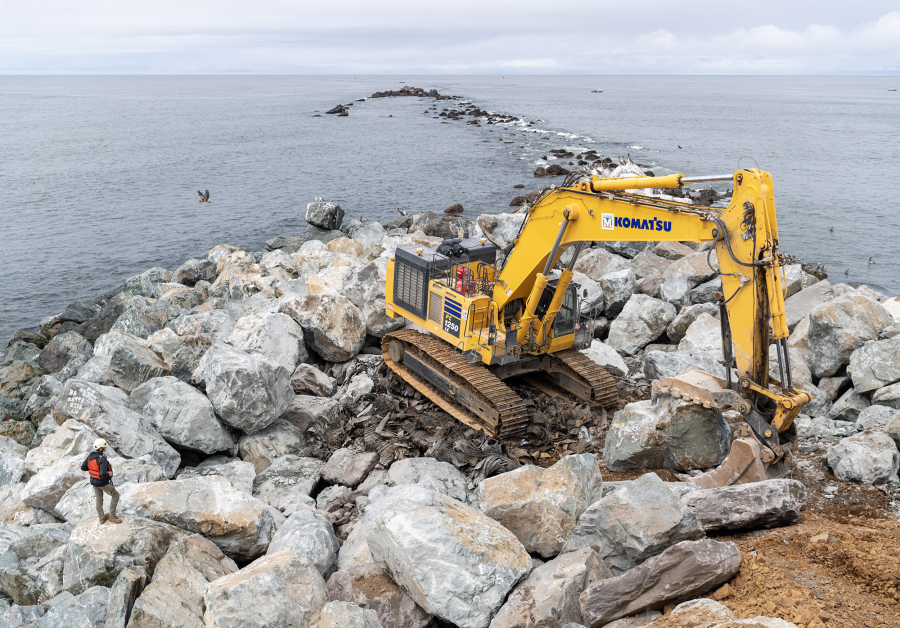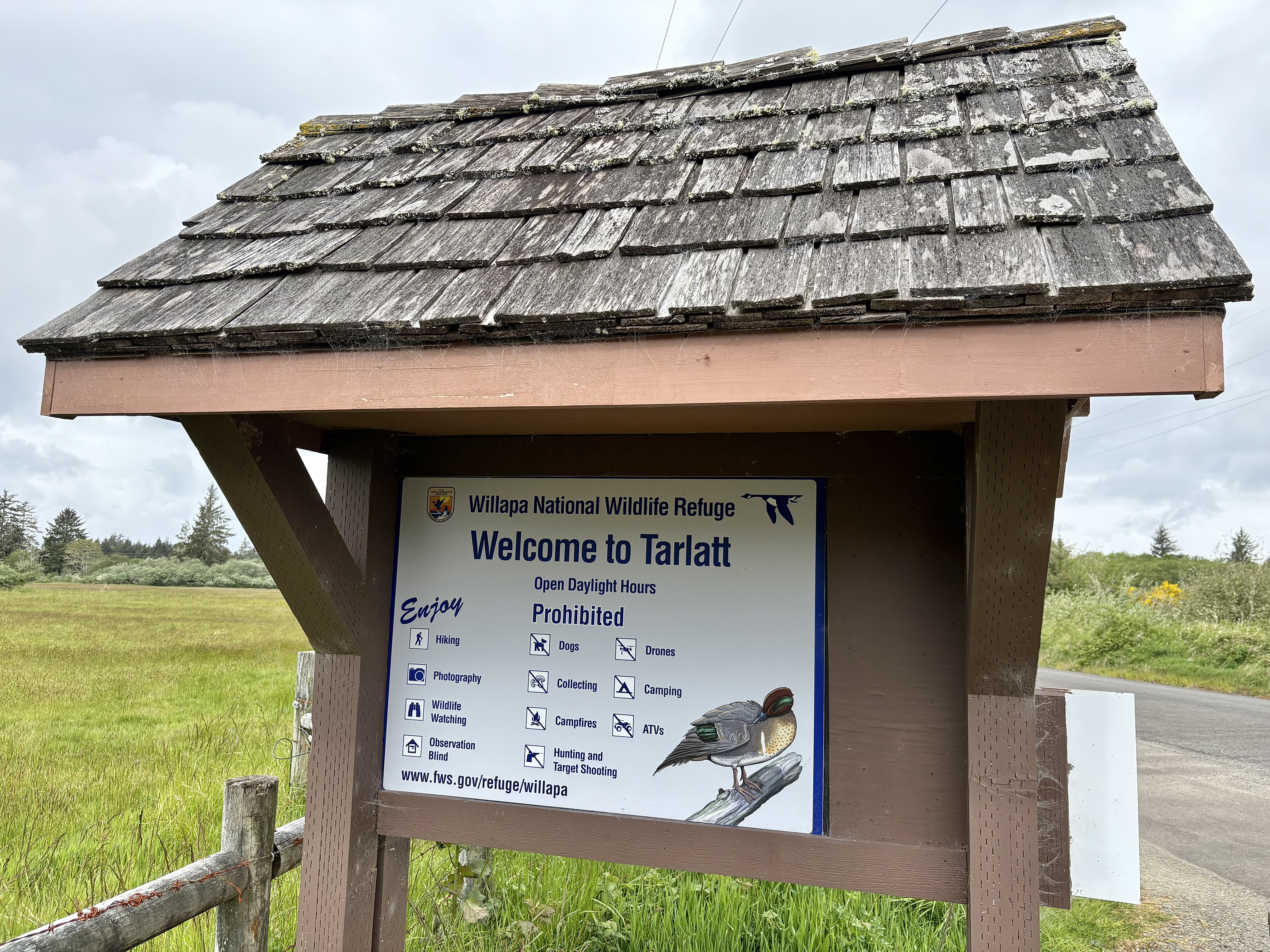32,000 rocks, $172M: Columbia jetty rehab almost done: More than $31 billion in goods pass river’s perilous mouth
Published 1:50 pm Thursday, July 10, 2025




CLATSOP SPIT — For most of the past two years, Jesse Allen has worked 12 hours a day, seven days a week operating a crane to move sedan-sized boulders miles out into the mouth of the Columbia River.
“You don’t want it to slip out and drop,” Allen said, sitting in the 240-ton crane’s cab Friday. “So when you grab a rock, you just think, ‘Yeah, that’ll work, that should hold,’ and you go for it.”
Allen and nine others at specialized construction firm J.E. McAmis have already precisely placed about 32,000 numbered stones as part of their contract to restore the half of the U.S. Army Corps of Engineers’ roughly 6-mile-long South Jetty that’s battered by the Pacific Ocean.
Now, after six years of work and with just a couple hundred feet of jetty left to rehabilitate, the $172 million project is nearly complete.
Trending
The South Jetty functions alongside two somewhat smaller stone barriers in Washington — North Jetty and “A” Jetty. Together, they allow commercial ships to cross the notoriously dangerous stretch of water where 2 million gallons of Columbia River water crashes into the churning, storm-prone Pacific every second.
The trio of jetties work with dams and channel dredging to support an estimated $31 billion in goods that international shippers move on the river each year. Those products include Japanese cars, American grain and Canadian mineral fertilizers.
“The mouth of the river is the gateway to the entire system,” said Neil Maunu, executive director of the Pacific Northwest Waterways Association, a trade association representing regional shippers, ports, businesses and public agencies. “It must function to allow the whole system to work.”
How the jetties work
Army Corps’ engineer and geologist Colter Bennett runs the jetty restoration project on the government side. As engineer-in-training Taylor Jacobs drove a beefed-up golf cart out on the jetty, Bennett explained the project’s history.
“The original construction of this was absurd,” Bennett called over his shoulder. “Trestle system with rail on top, and then a steam-powered train that would deliver the rocks.”
Trending
That 10-year initial project started in 1885, spurred by hundreds of shipwrecks along the ever-changing Graveyard of the Pacific.
Given that it’s battered by continuous surf, as well as periodic 40-foot swells every year, the jetty has needed about a dozen significant repairs throughout its life, Bennett said.
But the current project is the most significant and maybe the most needed.
“What we’re driving on, about 12 feet of it didn’t exist,” Bennett said, bumping down the new construction. “Prior to this project, the ocean had beaten the jetty down to the point where 12 feet of rock essentially was missing through this entire section.”
Other sections had been knocked below water level, even at low tide. Raising the jetty by as much as 22 feet isn’t cheap, and it hasn’t been easy. Standing on Allen’s crane later that day, Bennett explained why the Corps is going to all the trouble.
“If this jetty was gone tonight,” he said, “within a few days — maybe less, a few tide cycles — the federal navigation channel would go from 40, 45 feet deep to too shallow for ships to come in and out.”
That’s because the jetties work to narrow the mouth of the Columbia, pinching the river and speeding up the current to prevent sediment from settling to the bottom.
Although the Columbia stretches to 10 miles wide at some points just upriver, the distance between the north and south jetties is less than one-fourth that.
An engineering marvel
After spending the past six years with J.E. McAmis working his way from a machinery operator miner to quarry supervisor at the firm, Cody Pierson now runs the jetty project for the construction contractor.
Standing 3 miles out on the jetty Friday, Pierson offered details about the team as his walkie-talkie crackled.
“We got three haul truck drivers, one loader operator, two people in the office, me, the crane operator, there’s a spotter and then that excavator operator,” he said, pointing at a giant excavator gripping a Volkswagen Beetle-sized boulder below.
The team works together as a single organism placing stones — some about as big as a 40-foot shipping container and weighing about 40 tons — precisely down to the inch.
The stones are dense Oregon and Washington-mined diabase, blueschist and greenschist. Their time underground is brought to an abrupt end when McAmis miners trigger explosives packed down drilled shafts.
From there, heavy machinery breaks them into chunks before they’re either barged by ocean or driven by truck to Clatsop Spit. Haul truck drivers then take them out on the jetty to Allen, the crane operator, who passes each off to the heavy machine operator aided by a spotter.
That last job is key to making sure this latest version of the jetty enjoys a long life, explained Bennett, the Corps’ engineer.
“Every stone is inspected to be placed a certain way,” he said. “The spotter works in tandem with the operator to inspect all dimensions of the stone.”
Each boulder must fit together snuggly. More complicated still, they must be positioned so their smaller end absorbs the ocean’s blows, and the larger more solid end anchors them in place.
“Every rock that’s put down is touched with survey equipment to make sure it’s within a tolerance,” Bennett said.
Workers make it possible
That high-pressure work is further complicated by the fact construction on the jetty must be halted each winter because of the location’s extreme weather.
Keeping up the work demands an intense focus and dedication from the deft workers that Bennett said shows in a variety of ways.
“They’re essentially just doing a puzzle all day,” he said. “Every operator I’ve ever worked with has said that when they’re going to sleep, they’re seeing this stuff.”
That’s true for Allen, who Bennett said is one of less than 100 people around the country who could do his job — a fact partly responsible for his compensation, which ranges from $220,000 to $250,000 a year.
Outside the crane’s control room Friday, dozens of pelicans swirled above, cormorants dove for young salmon below and sea lions gathered on the last 200 feet of jetty still to be rebuilt.
Allen believes in the work he’s spent the last six years doing, values the camaraderie the jetty team shares and appreciates the scenery. But with a family at home and a ranch to run, too, the 45-year-old estimates he only has another decade before he trades his current riverview for one that’s a little more relaxing.
“We just see all the guys having a good time enjoying the retired life fishing,” he said. With a grin, he added, “We’re thinking where we went wrong.”
The Corps and J.E. McAmis expect the project to wrap up by the end of this summer. Meanwhile, J.E. McAmis is already working on another sediment control project, this one just a few miles away on Sand Island.
•••
Henry Brannan is part of The Murrow News Fellowship, a state-funded journalism project managed by Washington State University. Local participants include the Chinook Observer, The Columbian and The Daily News. For more information, visit news-fellowship.murrow.wsu.edu.













